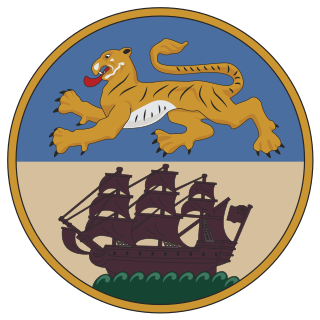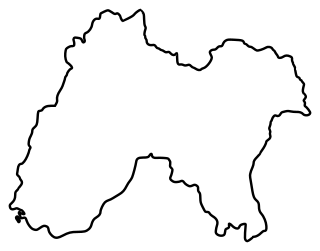Related Research Articles

The Constituent Assembly of India was partly elected and partly nominated body to frame the Constitution of India. It was elected by the Provincial assemblies of British India following the Provincial Assembly elections held in 1946 and nominated by princely states. After India's independence from the British in August 1947, its members served as the nation's 'Provisional Parliament', as well as the Constituent Assembly. It was conceived and created by V. K. Krishna Menon, who first outlined its necessity in 1933 and enshrined it as an Indian National Congress demand.

The Dominion of India, officially the Union of India, was an independent dominion in the British Commonwealth of Nations existing between 15 August 1947 and 26 January 1950. Until its independence, India had been ruled as an informal empire by the United Kingdom. The empire, also called the British Raj and sometimes the British Indian Empire, consisted of regions, collectively called British India, that were directly administered by the British government, and regions, called the princely states, that were ruled by Indian rulers under a system of paramountcy. The Dominion of India was formalised by the passage of the Indian Independence Act 1947, which also formalised an independent Dominion of Pakistan—comprising the regions of British India that are today Pakistan and Bangladesh. The Dominion of India remained "India" in common parlance but was geographically reduced. Under the Act, the British government relinquished all responsibility for administering its former territories. The government also revoked its treaty rights with the rulers of the princely states and advised them to join in a political union with India or Pakistan. Accordingly, the British monarch's regnal title, "Emperor of India," was abandoned.
The National Unionist Party was a political party based in the Punjab Province during the period of British rule in India. The Unionist Party mainly represented the interests of the landed gentry and landlords of Punjab, which included Muslims, Hindus and Sikhs. The Unionists dominated the political scene in Punjab from World War I to the independence of India and the creation Pakistan after the partition of the province in 1947. The party's leaders served as Prime Minister of the Punjab. The creed of the Unionist Party emphasized: "Dominion Status and a United Democratic federal constitution for India as a whole".

Bhim Sen Sachar was an Indian politician who served three times as the Chief Minister of Punjab.

The Council of State was the upper house of the legislature for British India created by the Government of India Act 1919 from the old Imperial Legislative Council, implementing the Montagu–Chelmsford Reforms. The Central Legislative Assembly was the lower house.

After power transformation, on 15 August 1947, Jawaharlal Nehru assumed office as the first Prime Minister of India and chose fifteen ministers to form the First Nehru ministry.

General elections were held in British India in December 1945 to elect members of the Central Legislative Assembly and the Council of State. The Indian National Congress emerged as the largest party, winning 57 of the 102 elected seats. The Muslim League won all Muslim constituencies, but failed to win any other seats. Of the 13 remaining seats, 8 went to Europeans, 3 to independents, and 2 to Akali candidates in the Sikh constituencies of Punjab. This election coupled with the provincial one in 1946 proved to be a strategic victory for Jinnah and the partitionists. Even though Congress won, the League had united the Muslim vote and as such it gained the negotiating power to seek a separate Muslim homeland as it became clear that a united India would prove highly unstable. The elected members later formed the Constituent Assembly of India.

Provincial elections were held in British India in January 1946 to elect members of the legislative councils of the Indian provinces. The Congress, in a repeat of the 1937 elections, won (90%) of the general non-Muslim seats while the Muslim League won the majority of Muslim seats (87%) in the provinces.

The Legislatures of British India included legislative bodies in the presidencies and provinces of British India, the Imperial Legislative Council, the Chamber of Princes and the Central Legislative Assembly. The legislatures were created under Acts of Parliament of the United Kingdom. Initially serving as small advisory councils, the legislatures evolved into partially elected bodies, but were never elected through suffrage. Provincial legislatures saw boycotts during the period of dyarchy between 1919 and 1935. After reforms and elections in 1937, the largest parties in provincial legislatures formed governments headed by a prime minister. A few British Indian subjects were elected to the Parliament of the United Kingdom, which had superior powers than colonial legislatures. British Indian legislatures did not include Burma's legislative assembly after 1937, the State Council of Ceylon nor the legislative bodies of princely states.

The Bengal Legislative Assembly was the largest legislature in British India, serving as the lower chamber of the legislature of Bengal. It was established under the Government of India Act 1935. The assembly played an important role in the final decade of undivided Bengal. The Leader of the House was the Prime Minister of Bengal. The assembly's lifespan covered the anti-feudal movement of the Krishak Praja Party, the period of World War II, the Lahore Resolution, the Quit India movement, suggestions for a United Bengal and the partition of Bengal and partition of British India.

Elections to the Punjab Provincial Assembly were held in January 1946 as part of the 1946 Indian provincial elections.
The Interim East Punjab Assembly was a unicameral governing and law making body of the newly formed Indian state of East Punjab.
Harendra Kumar Sur was an anti-colonial Bengali politician, and a representative of East Pakistan to the Constituent Assembly of Pakistan.
Jnanendra Chandra Majumdar was an anti-colonial Bengali politician, and a representative of East Pakistan to the Constituent Assembly of Pakistan.

Akshay Kumar Das was a Bengali Hindu politician of Pakistan, who served as a representative of East Pakistan in both the First and Second Constituent Assemblies, and held multiple ministries across the 1950s in governments formed by different political parties.
Sardar Asad Ullah Jan Khan was a Pakistani Pakhtun politician from Kulachi, who represented North-West Frontier Province in the Constituent Assembly of Pakistan. Chieftain of the Gandapur tribal segment, Khan commanded influence in the society; besides, he was a local land magnate.
Shaikh Karamat Ali was a Pakistani Muslim League politician from Punjab, Pakistan.
Lala Avtar Narain Gujral was an Indian politician from Punjab and the father of I. K. Gujral, the 12th prime minister of India, and artist Satish Gujral. He represented the non-Muslim population of West Punjab in the Constituent Assembly of Pakistan for a few months.
Provincial Assembly elections were held in Dominion of Pakistan in 1951 to elect all 192 members of the Provincial Assembly of West Punjab along with other provincial election in North-West Frontier Province. It was Pakistan's first provincial assembly election. Pakistan Muslim League won the election, and defeated the JAML coalition of the Jinnah Muslim League and All-Pakistan Awami Muslim League.
References
- ↑ Bangash, Yaqoob Khan (4 July 2022). "Anglo-Indians and the Punjab Partition: Identity, Politics, and the Creation of Pakistan". The Journal of Imperial and Commonwealth History. 51: 124–155. doi: 10.1080/03086534.2022.2086202 . ISSN 0308-6534.
- 1 2 "Press Infromation [sic] Bureau's Morgue and Ref Series: (1) Analysis of the Results of General Elections to the Central and Provincial Legislatures Held In 1945-46 (2) Indian Political Parties, and (3) Provincial Minstries 1937-45". Home Political, ID: HOME_POLITICAL_I_1945_NA_F-79-46. National Archive of India.
- ↑ Report of The Proceedings of the Twenty-Fifth Session of the National Liberal Federation of India (PDF) (Report). March 1945.
- ↑ Government of Punjab. "First Legislative Assembly of Punjab (August 15, 1947 to January 25, 1949)".
- ↑ "Punjab Speaker Defeated: Pakistan Assembly". Times of India. 5 July 1947. p. 8. ProQuest 347195954.
- ↑ East Punjab Legislative Assembly Official Debates: 1st November 1947 (PDF) (Report). Vol. 1. East Punjab Government Press. 1947.